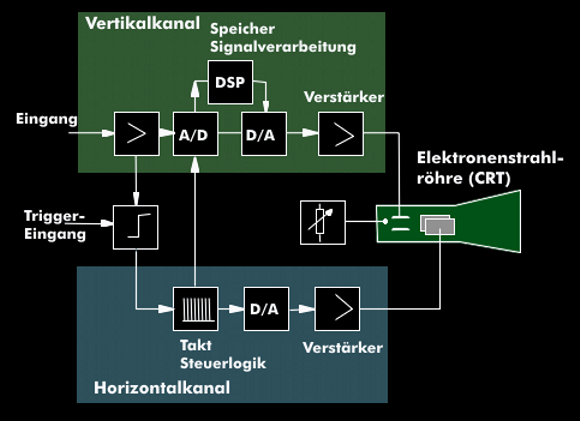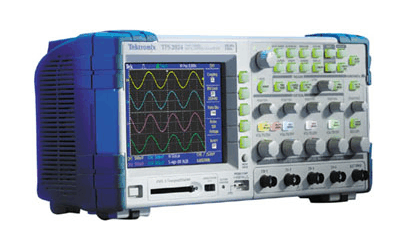digital storage oscilloscope (DSO)
A digital oscilloscope or a digital storage oscilloscope(DSO) is a measuring instrument that digitizes, processes and stores analog input signals and displays them in analog signal form. The distinction from the classic storage oscilloscope with analog screen storage lies in the fact that this group of devices neither digitizes nor processes the signals and cannot make them available for further processing.
The structure of digital oscilloscopes
In terms of construction, the digital oscilloscope has certain similarities with an analog oscilloscope, which is related to the fact that both measuring instruments are designed for comparable applications. The input channel of a digital oscilloscope consists of an A/D converter in which the input signals sampled in the sample and hold circuit are digitized and stored in the downstream semiconductor memory. To be able to display the signals again in analog signal form, the vertical channel in front of the display has a D/A converter.
The time deflection of the horizontal channel and the sampling rate at which the vertical signal is sampled are directly related. For example, if the digital oscilloscope operates with a time resolution of 100 ms/cm and 10 samples/cm are displayed, then the sampling rate is 10 ms/sample.
The triggering of digital oscilloscopes differs in one essential point from that of analog oscilloscopes. In order to be able to display the trigger time itself, in analog oscilloscopes the input signal is delayed until the time hysteresis of the triggering is bridged. In digital oscilloscopes, the digitized data can be run through a shift register and thus the trigger time and time ranges that lie before the trigger time can be displayed. As with the logic analyzer, the trigger is used to stop the read-in data
The A/D converter is the central component of digital oscilloscopes and determines their essential properties, such as the resolution, the displayable bandwidth and the rise time.
Characteristics of digital oscilloscopes
The resolution and the accuracy of the display are directly related to each other. The resolution characterizes the possibility of distinguishing individual partial values, while the accuracy characterizes the agreement of a displayed value with the actual value. The resolution of the A/D conversion is thus a matter of quantization. At 6 bits, corresponding to 64 gradations, the accuracy is 1.56%, at 8 bits 0.19% and at 10 bits quantization 0.098%.
The memory bandwidth of digital oscilloscopes is determined by the sampling rate with the inclusion of the sampling theorem. According to this the sampling rate must be twice as high as the highest frequency to be sampled. If the digital oscilloscope has a highest sampling frequency of 1 GHz, then the memory bandwidth is 500 MHz. Like the memory bandwidth, the rise times of digital oscilloscopes are also dependent on the sample rate. Approximately, the usable rise time results from the minimum sampling interval multiplied by the factor 1.6. Thus, if the sampling interval is 1 GHz, or 1 ns, then the usable rise time is 1.6 ns.
DSP technologies improve these limits even further for high-speed measurements. With these techniques, bandwidth values of 15 GHz and higher and rise times of about 30 ps are realized. Here, the relationship between bandwidth and rise time is approximate: Bandwidth = 0.5/rise time.


